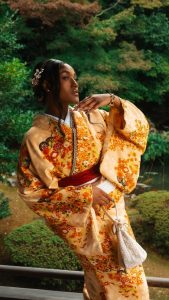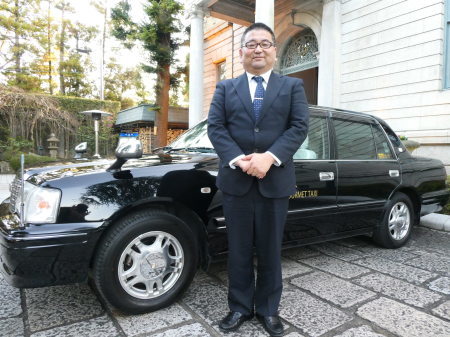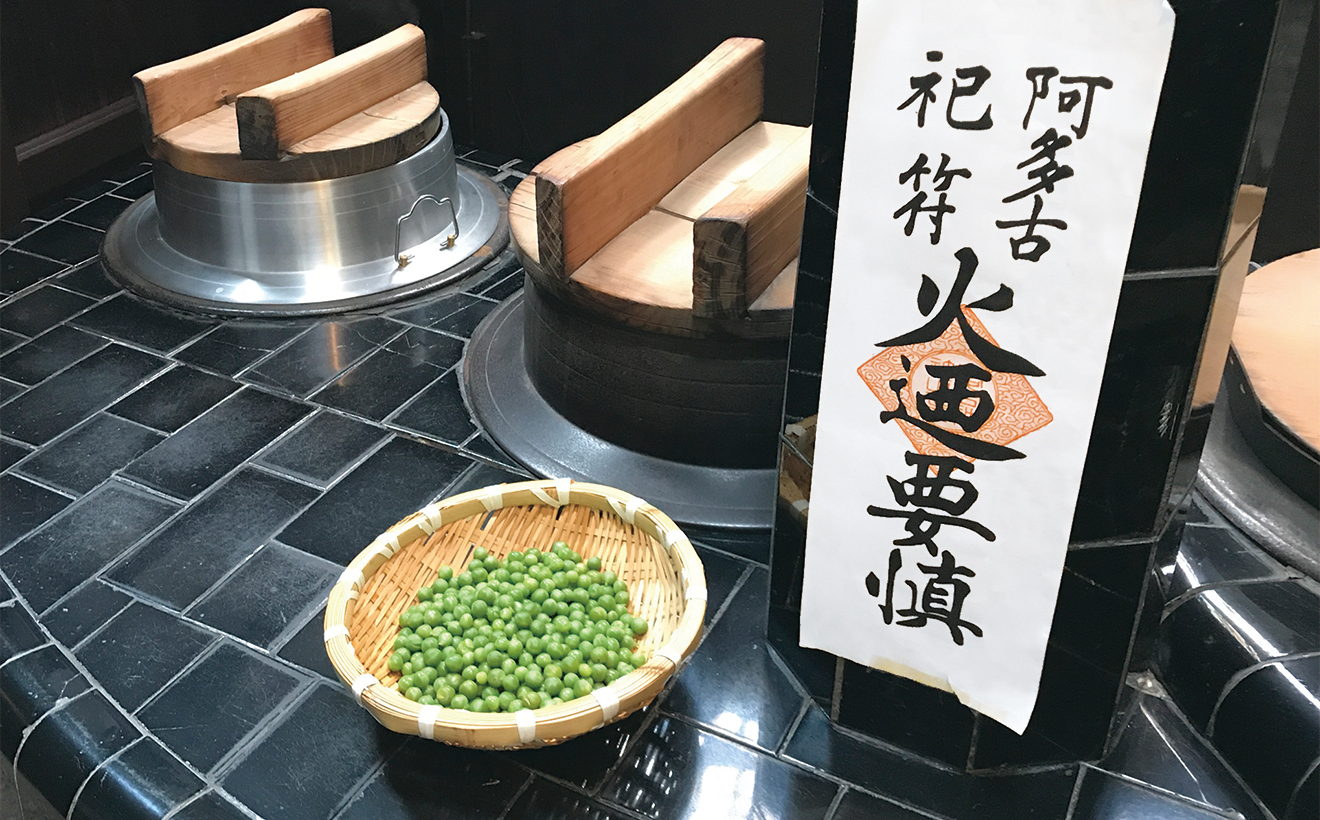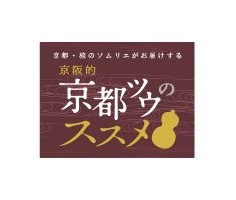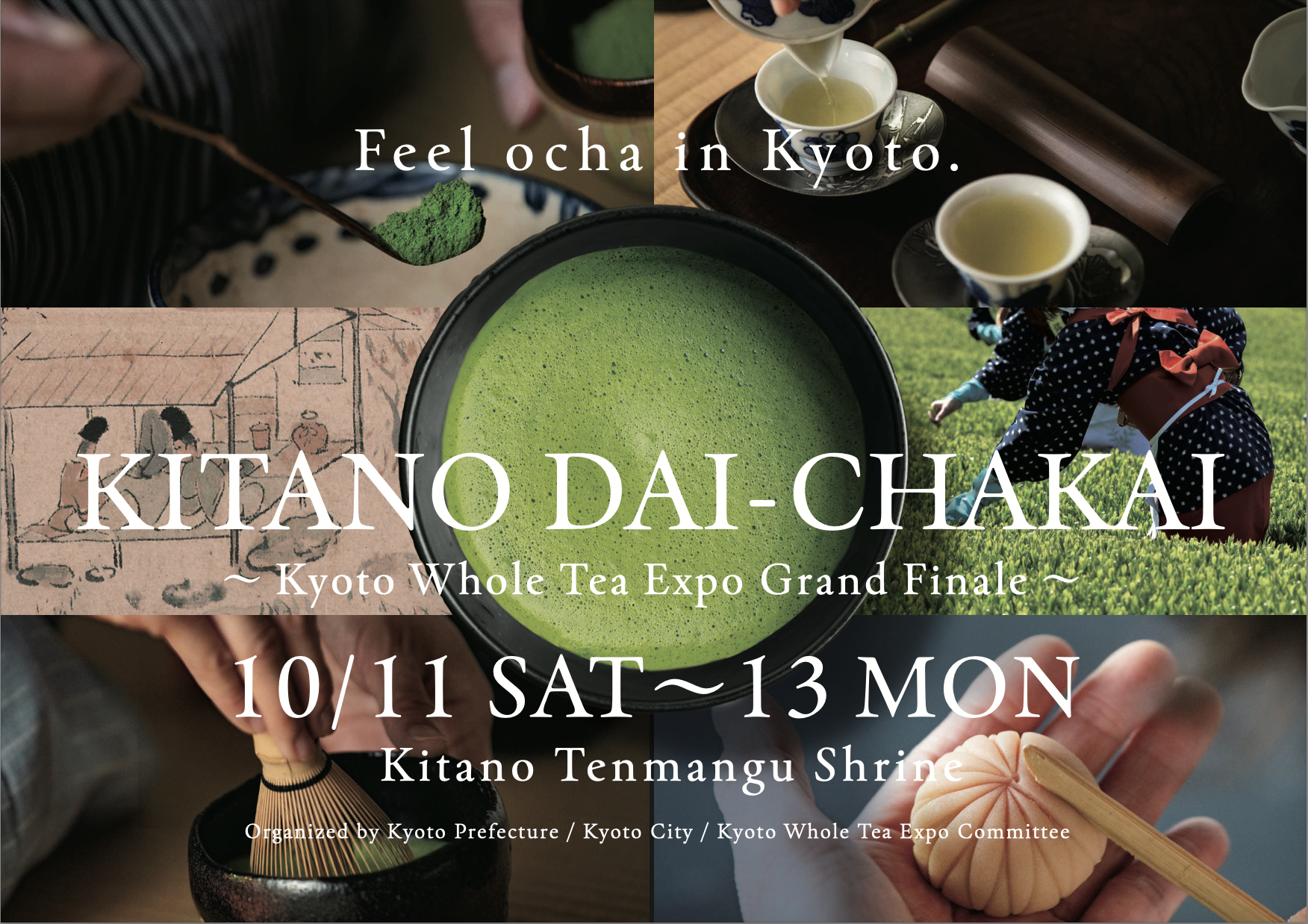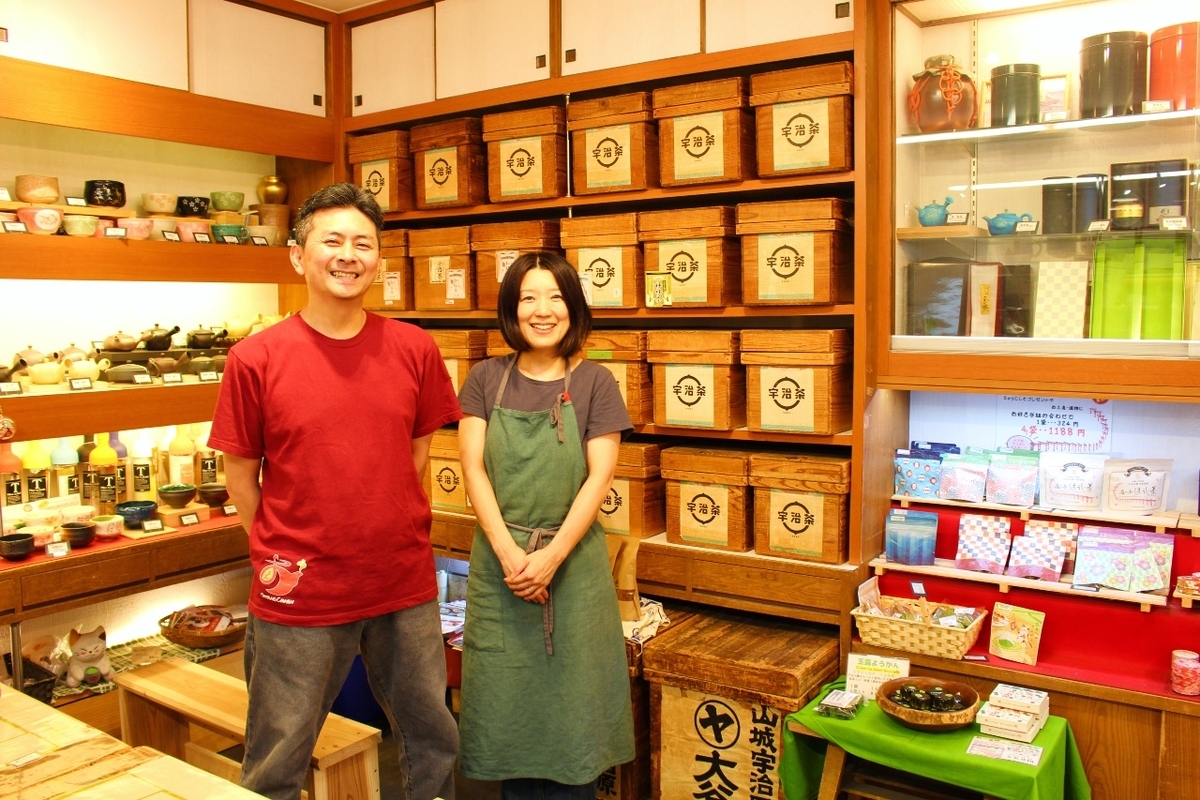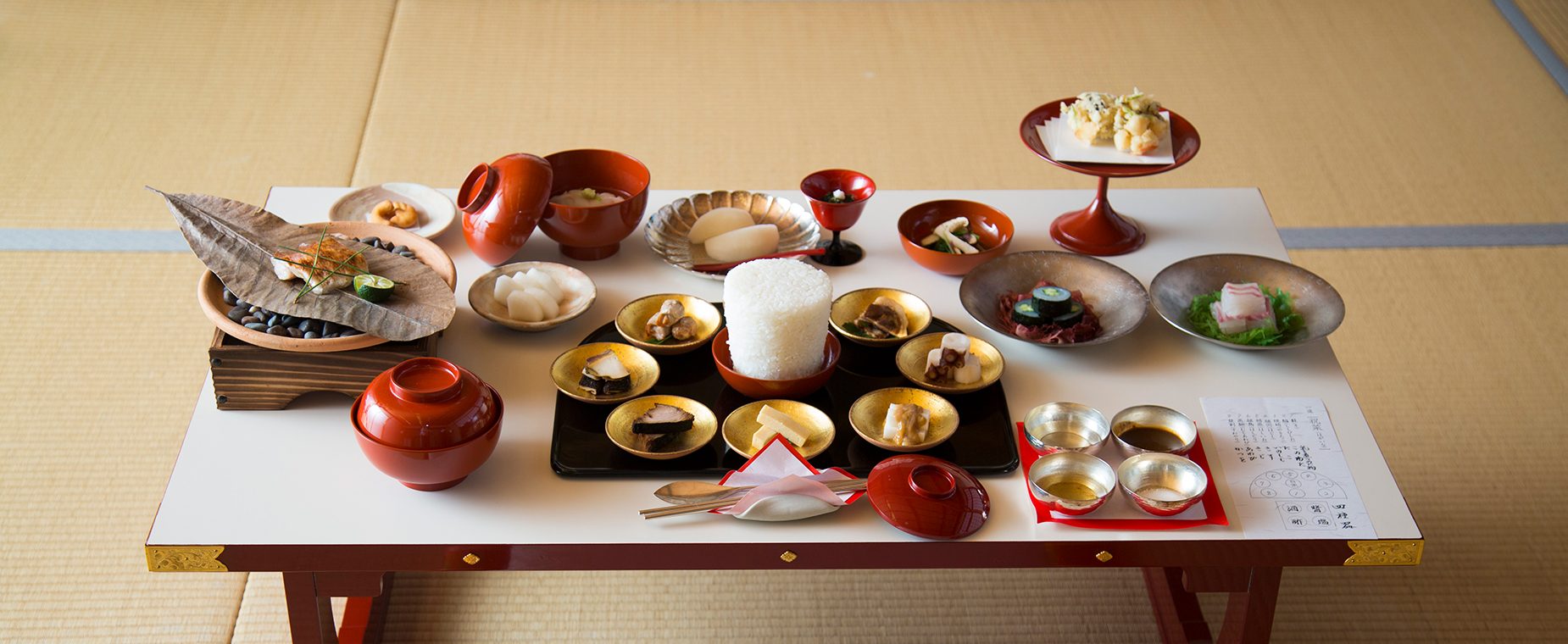
Kyo-Ryori Rokusei is a restaurant in the Okazaki area of Kyoto City. (Kyo-ryori: a general term for Kyoto cuisine) Founded in 1899, now the third generation owner Hiroyuki Horiba is keeping the tradition of the first generation’s taste. The restaurant is most famous for its Teoke Bento, filled with colorfully arranged seasonal delicacies of Kyoto cuisine (and served in the wooden teoke pails made by the Living National Treasure and second-generation oke artisan, Kiyotsugu Nakagawa). But it also has another specialty that is not as well known, the Heian Dynasty Cuisine. Mr. Horiba created this elegant fare by researching classical literature, and now the pursuit has become his lifework. Enjoy this interview with Mr. Horiba on the way he encountered the Heian gastronomy and how he developed his own version, along with elaborate photos of the course meal!
Hiroyuki Horiba /Third generation owner-chef of Kyo-Ryori Rokusei
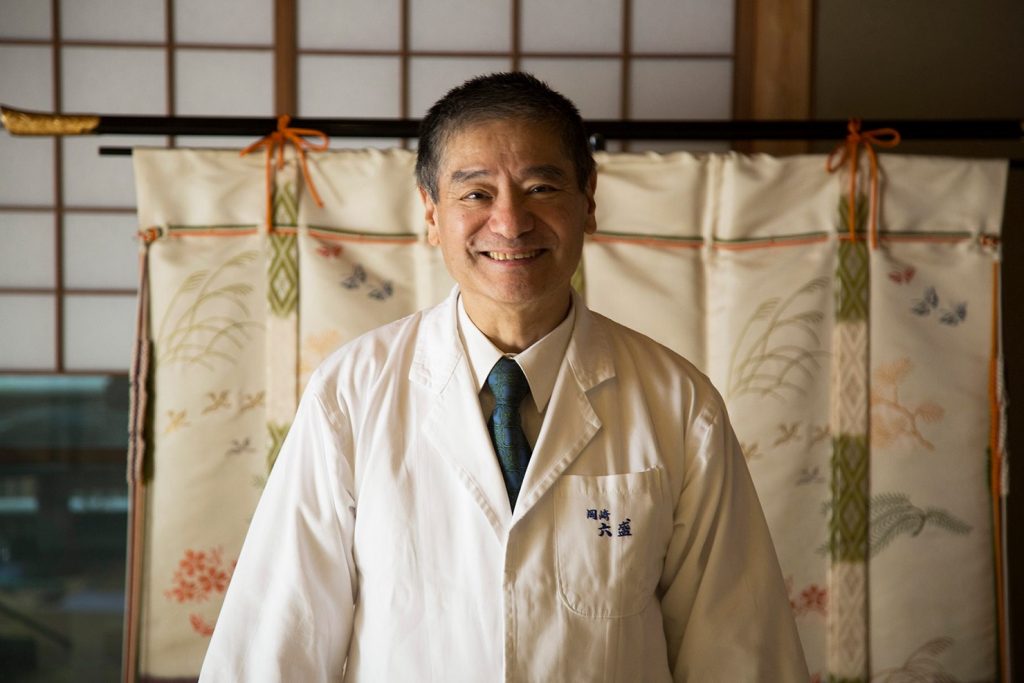
Hiroyuki Horiba was born in 1947. He trained at a Japanese restaurant in Tsukiji, Tokyo after he graduated from university. He started working in his family business when he was 24 and honed his skills under his predecessor. In 1994, the year of the 1200th Anniversary of Kyoto (when it became the capital of Japan: Heian-Kyo), he started serving the Heian Dynasty Cuisine. (Sosaku Heian Ocho Ryori)
Kyo-Ryori Rokusei
The first generation started a catering business and then founded Kyo-Ryori Rokusei in 1899. They made it their rule never to have branch restaurants, and only prepare their dishes within reach of the owner’s eyeshot. “Cooking is not what a machine does, so we must keep a sharp eye on what is going on, and only serve dishes that taste satisfying to the owner” is their principle, which they haven’t changed over the generations.
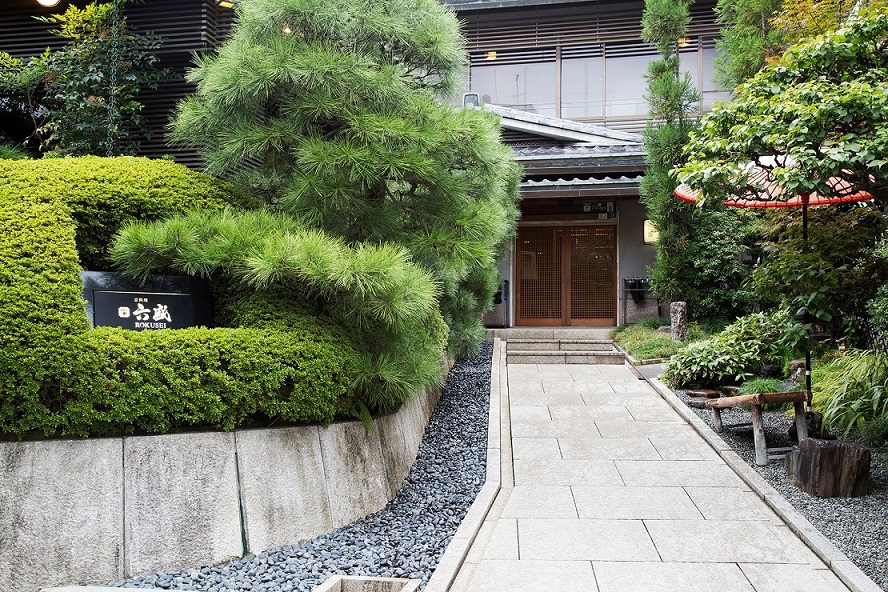
The shop is to the west of Heian-jingu Shrine, in a pleasant setting on the north side of the canal.
Interview
—– What inspired your creation of the Heian Dynasty Cuisine?
One time, a customer asked me, “ What exactly is Kyo-Ryori (Kyoto cuisine)?” I searched for the answer, but I couldn’t find any definite explanation. There seemed to be many theories about the origin of Kyo-ryori. Some say it’s the result of a fusion of the Shojin-ryori (Buddhist vegetarian cuisine) that came in with Zen Buddhism, the Kaiseki-ryori of Chanoyu (tea ceremony cuisine), and the Honzen-ryori (Samurai-class cuisine). I guessed that the origin of Kyo-ryori might be in the Heian Dynasty Period (794-1185). I looked into historical sources and documents, but all I could find were some old pictures that didn’t help me get a clear image of what they were actually like. I felt like I should be able to have an answer to my customer’s simple question, so I resolved to find my own answer to the question.
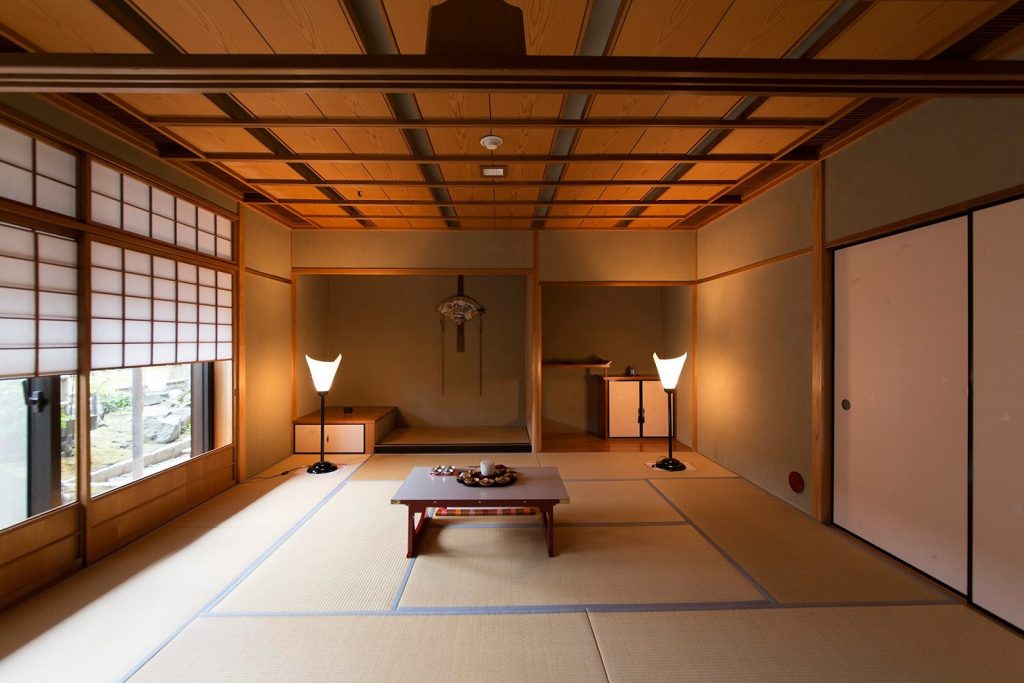
Guests are shown into a softly lit room, the way it would have been in the Heian Period.
—– What was the fare of the Heian Period people like?
First, I went to the National Diet Library to check research materials related to the culinary aspects of the Heian Period, and also asked specialists for their expertise. One of the specialists was Ayao Okumura, who is a researcher of culinary culture and traditional cooking. Mr. Okumura said, “That sounds exciting!” and showed much interest in my project. The other is the director of the Costume Museum, Yohei Izutsu. The concept of the Costume Museum is to “feel the world of Heian Period through the manners and customs” of the time. Mr. Izutsu shared a lot of his knowledge on the gastronomy of the era, including the tableware and the ways the rooms were furnished.
In Nenjyu-gyoji-emaki (literally, the picture scroll of annual events; painted in the 12th century), the formal dinner of aristocrats is depicted. Once, Mr. Okumura tried reproducing the dinner for me as precisely as possible. It was fascinating, but at the same time, I thought that the taste was not so great. In the Heian Period, the concept of seasoning was not a part of cooking. The food was prepared very simply by either grilling, boiling, or steaming, and the seasoning was not done in the kitchen. According to a record in Ruijyuzouyousho (12c) of a formal feast served in the Higashi-Sanjo Estate by minister Tadazane Fujiwara, a great variety of seafood and meat were served on small tables called daibans, and each person used the set of four condiments called yogusamono placed in front of the dishes to season them as they wished.
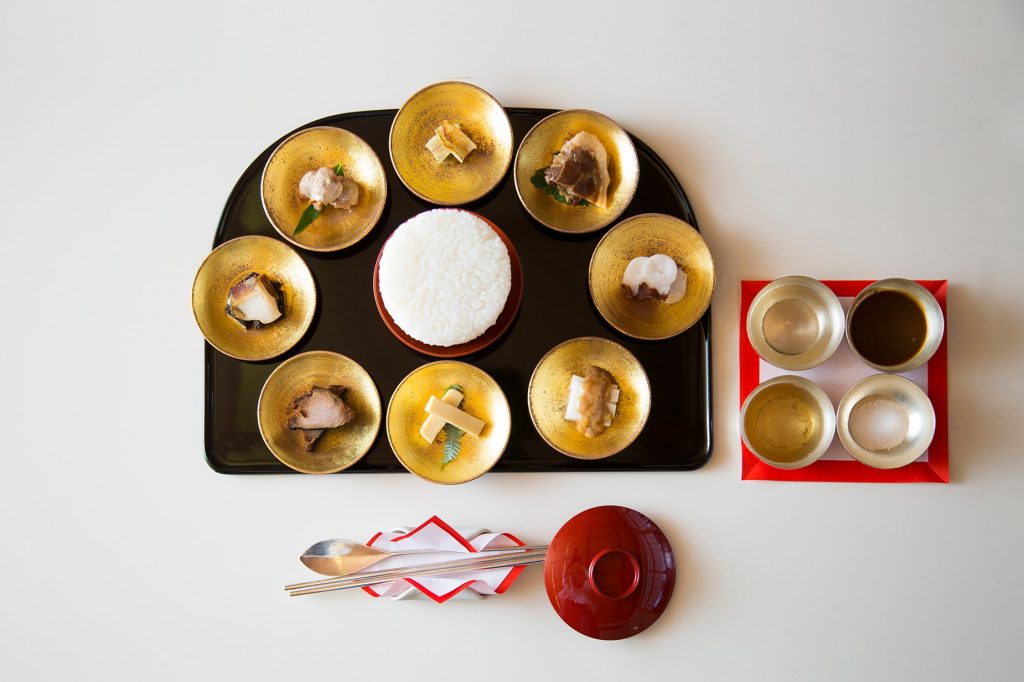
First course – Hogaina
Appetizers named for the blessing of health and longevity. These are placed on the daiban tray from the beginning. The tall cylindrical mound in the center is the ii (rice) called omono. The serving is more than abundant, but according to customs, it’s fine not to finish eating all of it. The dishes around the rice are called omawari (literally, around), or awase (literally, accompany) because they literally accompany the rice. The more the number of the dishes, the better it was thought; hence the word okazu, meaning the dishes accompanying rice in contemporary Japanese, literally means “number.” The guests season the omawari as they like, using the four kinds of condiments. The omawari are eaten together with the plain white rice in the center. However, in Mr.Horiba’s edition, each dish is flavored so they also make good matches with sake. The omawari (clockwise from the center below): so an ancient variation of cheese made by boiling down milk, shishi-bishio a kind of shiokara (salted and fermented seafood guts , the photo is of sea cucumber), yaki-tako grilled octopus, hojishi the original namasu was marinated meat (photo: boar meat), hoshiio dried fish (photo: whiting sprinkled with salt and grilled), hoshidori salted and sun-dried poultry (photo: grilled pheasant), mushi-awabi steamed abalone, suwayari dried strips of fish. (photo: smoked bonito tuna)
—– What were the four condiments?
Vinegar, sake, salt, and hishio. Hishio was a sauce that is said to be the origin of soy sauce. The ingredients for hishio, such as seafood or poultry, were probably salted and dried for preservation.
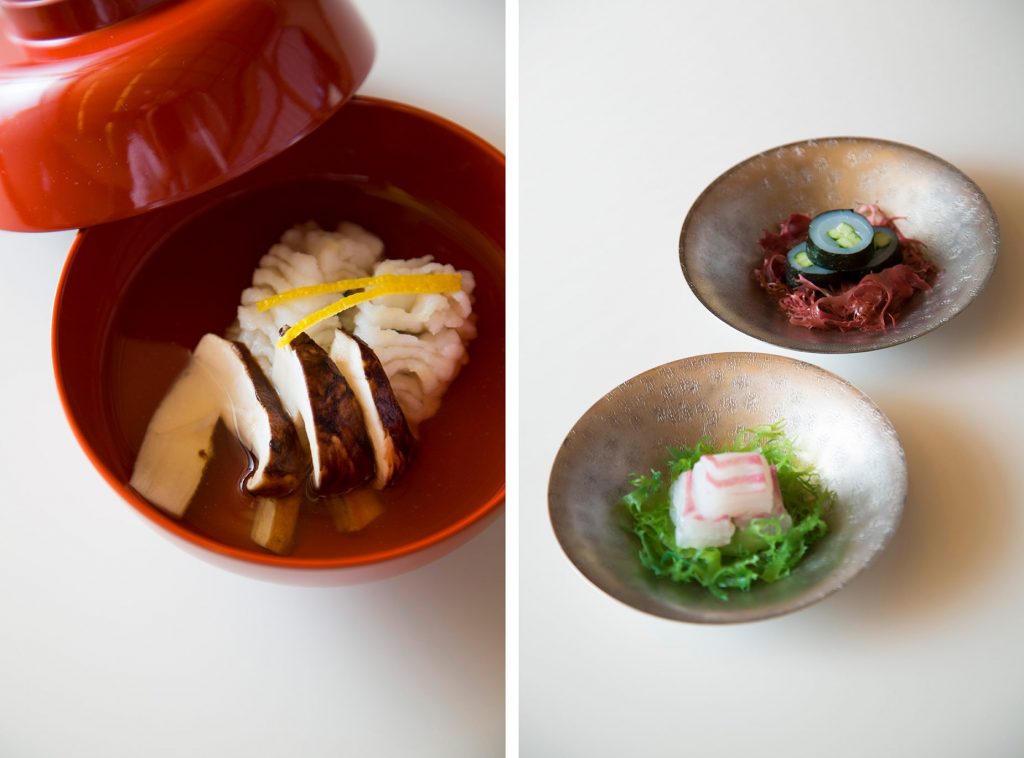
Second course – Atsumono (left)
Back in those days, the dishes were cooked in advance and placed on the table, so they were all cold. The only food that was served warm was the soup; hence it’s named atsumono (literally, the hot dish). Photo: a bowl of autumn conger eel and matsutake mushrooms in soup, with a lavish savory aroma that represents the season.
Third course – Kassen (right)
Sashimi (raw seafood). Being able to eat raw fish in the capital city Kyoto, far away from the sea, was considered the greatest luxury. Photo: Sashimi of sea bream and squid, placed in rising layers on a tin dish like they were in the ancient days.
—– What did you find depicted in the ancient sources?
There were rice, bowls of soup, small side dishes in goblets, shellfish, raw seafood or meat, dried seafood or meat, and vegetable dishes served on daiban tables. When you look at the pictures, they look extravagant, which might be because people appreciated the visual experience, looking at the aesthetic appearance, more than actually tasting them.
According to Mr. Izutsu, the act of dining was regarded as being something very private for the Heian aristocrats, so talking about food from a gourmet point of view was considered vulgar. In fact, they even avoided eating in front of others. Perhaps that’s why they refrained from leaving behind many records, or expressions, related to their dining.
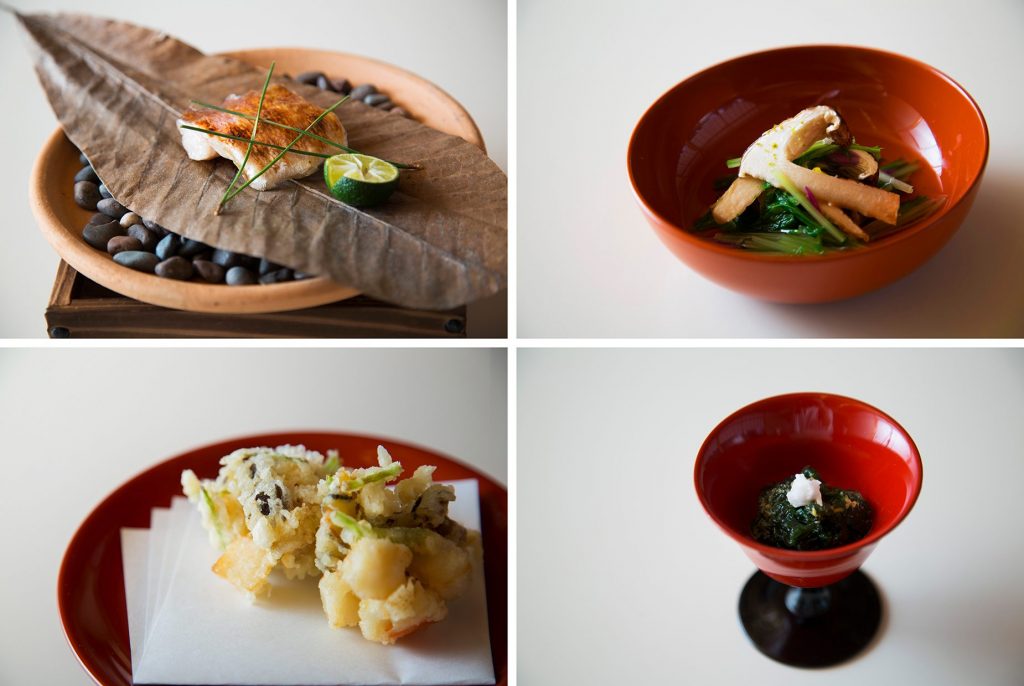
Fourth course – Aburimo (upper left)
Equivalent to today’s yakimono (a grilled dish). This dish was mostly prepared by plain grilling in the Heian Period. Grilling accompanied by the process of flavoring by miso or soy sauce is said to have started only after the Muromachi Period (1336-1573). Photo: tilefish sprinkled with salt and grilled. The fish is crisply roasted along with its delicate scales, then served on top of heated pebbles in unglazed earthenware.
Fifth course – Chosai (upper right)
A dish mainly using vegetables and dried foods. Nimono (the type of dishes cooked in broth) and aemono (the type of dishes dressed with sauce) were made only after the Muromachi Period, but this was added to Mr. Horiba’s edition. Photo: Matsutake mushrooms and mizuna (a type of mustard leaf) in broth, ohitashi.
Sixth course – Agemono (lower left)
In fact, the only deep-fried foods in the Heian Period were the deep-fried confections called karagashi; again, it is only after the Muromachi Period that other deep-fried dishes appeared. This is also a part of Mr. Horiba’s special arrangement. Photo: Deep-fried sazae (turbo), shimeji mushrooms, and mitsuba parsley.
Seventh course – Kubotsukimono (lower right)
Today’s sunomono (a vinegared dish) served in a goblet. Originally, dried foods were simply rehydrated, and raw foods were just chopped and rinsed with vinegar. Photo: Suizenji-nori, a type of freshwater algae.
—– How did your research on the Court gastronomy lead to your creation of the Heian Dynasty Cuisine?
I was hoping to serve something new to commemorate the 1200th Anniversary of Kyoto (from its establishment as the capital of Japan: Heian-Kyo) in 1994, so I decided to serve the Heian Court cuisine to our customers. It took five years since I started my research on the dynasty’s fare, and went through much trial and error, until I finally developed something satisfying enough to serve in our restaurant.
It wasn’t easy to conform to the rules of the era and create satisfactory dishes using only simple seasoning and many dried foods. It’s only natural that I wish guests coming all the way to Kyoto to enjoy their meals will be provided with a Kyoto-like splendor: a variety of flavorful dishes presented beautifully to the eyes.
As a result, I decided not to simply reproduce the taste of a millennium ago, but based on the inspirations I got from the Heian Court banquet feasts; I added my original ideas. I made use of robust dashi broth, and creatively added touches of different flavors so the dishes will be tailored to delight the taste buds of modern-day customers: That is the Heian Dynasty Cuisine.
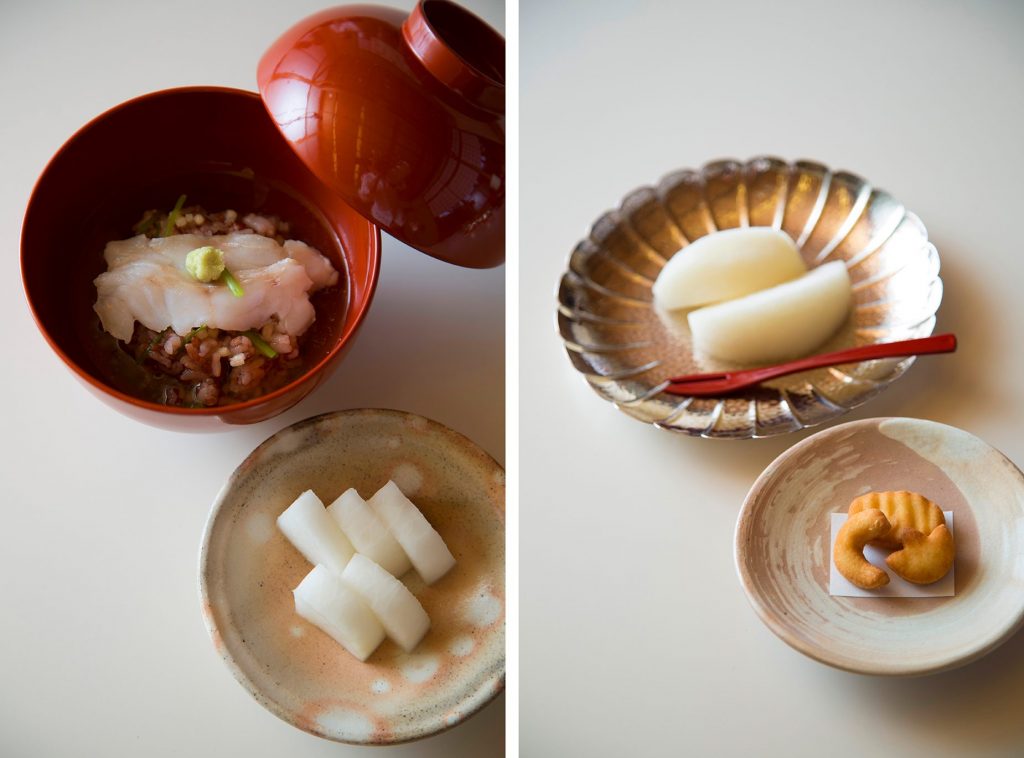
Eighth course – Hime-ii (left)
The auspicious red color of akagome (red rice) is favored. Photo: Steamed tilefish over red rice, with daikon radish pickled in rice bran.
Ninth course – Kigashi (upper right)
In the Heian Era, “sweets” meant fruits. Chestnuts, tangerines, apricots, peaches, and persimmons were served. Photo: nashi (Asian pear)
Tenth course – Karagashi (lower right)
A deep-fried confection, also called karakudamono, made by deep-frying rice flour, wheat flour, soybeans, or red beans kneaded with amazura (the sap of a type of wild grapevine, used instead of sugar) or starch syrup. Exotic shapes were especially favored at the time. Photo: Wheat flour and honey kneaded and deep-fried.
—– In detail, which features of the epoch were chosen to be recreated?
Firstly, the appearance of the food. The principle of the grand banquet fares at the time was that the food is served as takamori, in a high mound. This is likely to be the origin of the basic way Japanese food is served in tatemori, the style of laying out the food in a vertically accentuated manner. Secondly, the utensils. Chopsticks were called kai back then, and those chopsticks and spoons were made of silver. The tableware was made of urushi lacquerware, unglazed earthenware, silverware, and brass. Thirdly, the serving style. Based on the rule of “Isshu Ikki (one kind in one vessel),” rather than serving an assortment of foods on one dish, each food was served in its own plate or bowl. Fourthly, the daiban tabless. There was a room where the Court maids kept the daiban tabless with special care called daibandokoro, which is probably the origin of the Japanese word for kitchen, daidokoro. Fifthly, the seating. Instead of using zabutons (cushion seats, stuffed with cotton), they used to use a portable tatami mat called shitone and placed it on the floor to make seating for meals. I wanted to reproduce the Heian Period setting in our restaurant as much as possible, so I had the silver chopsticks and spoons, the daiban tables, and shitone mats custom made for the purpose.
Also, when we show our guests who chose the Heian Dynasty Cuisine to their room, we have all the lights in the room turned off except for the andon (traditional-style floor lamps). The furnishing of the room; the classical textile screens, the trademark of the nobles – hi-ougi (cypress folding fan) – decorated in the tokonoma alcove, and the slight scent of incense filling the dimly lit room; all perfectly express the world of In Praise of Shadows (essays on Japanese aesthetics by novelist J Tanizaki). Guests are first served a glass of kusu-zake (a spiced sake) and make a toast. Then, the lights are turned on, and the time of gourmet pleasure begins: That’s how the courtly experience commences.
—- Finally, is there anything you’d like to endeavor to do next?
Well, the research on the Court cuisine has become something like a life-long pursuit for me. What I showed you today is one form of accomplishment. Still, I won’t deny the possibility of a new development depending on how the research progresses. As a chef in Kyoto, I have given form to my personal interpretation of the Court gastronomy, which I believe is the origin of Kyo-ryori, and I will be happy if many people come to have a taste of it. I hope my guests will be inspired by each dish, and enjoy the atmosphere of the Heian Dynasty. Ultimately, if the Heian Dynasty Cuisine becomes the new signature fare of Rokusei, I would be delighted.
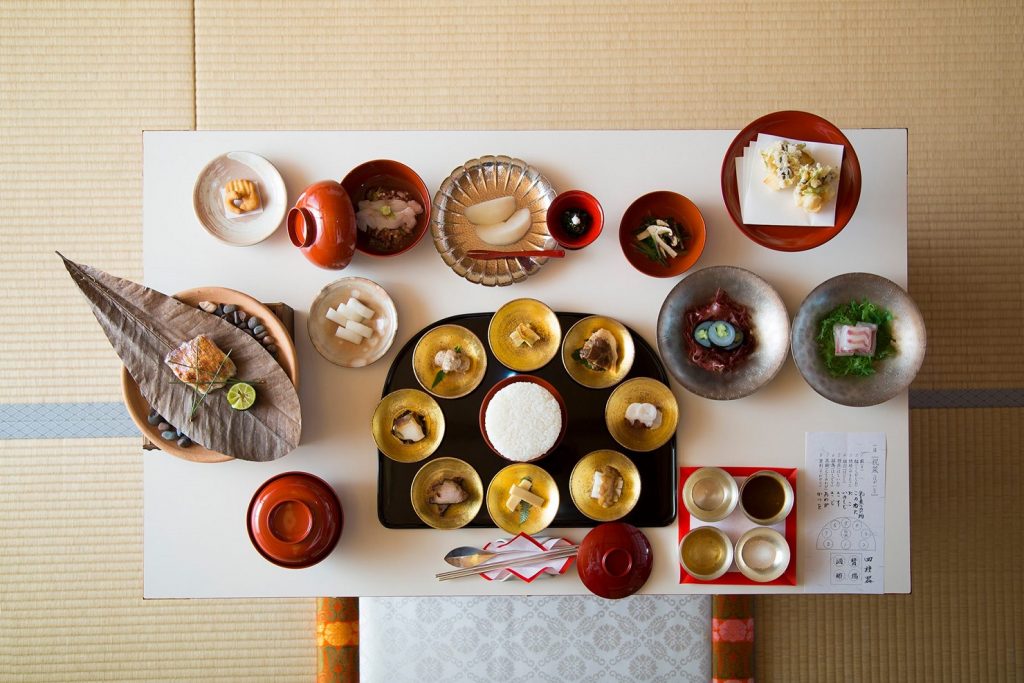
The Heian Dynasty Cuisine (Sosaku Heian Ocho Ryori)
13,200yen (Tax included/ 15% Service Fee not included), Number of persons: 2 – 12, Reservations required a week in advance
Kyo-Ryori Rokusei
Address: 71 Okazaki Nishi-Tenno-cho, Sakyo-ku, Kyoto
Hours: Weekdays 11:30 – 14:00 / 16:00 – 21:00 (L.O. 20:00); Sat, Sun & Holidays 11:30 – 21:00 (L.O. 20:00)
Closed: Mondays (Open on Holidays)
Tel: 075-751-6171
Official website
INTERVIEW
TEXT BY MAE KOORI
PHOTOGRAPHS BY YOUSUKE TANAKA
17.11.20 MON 15:37

